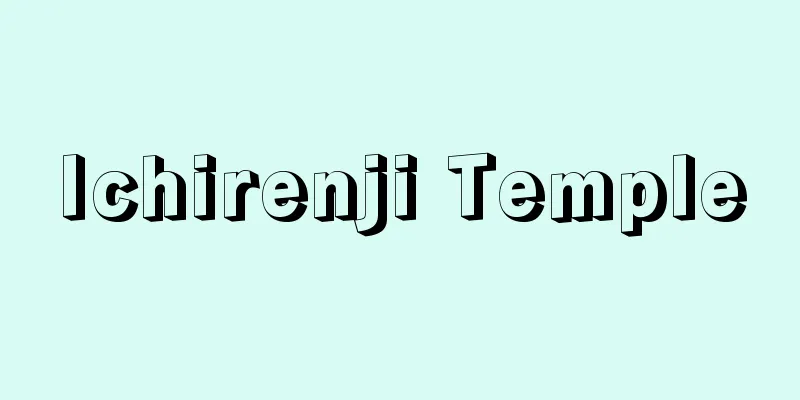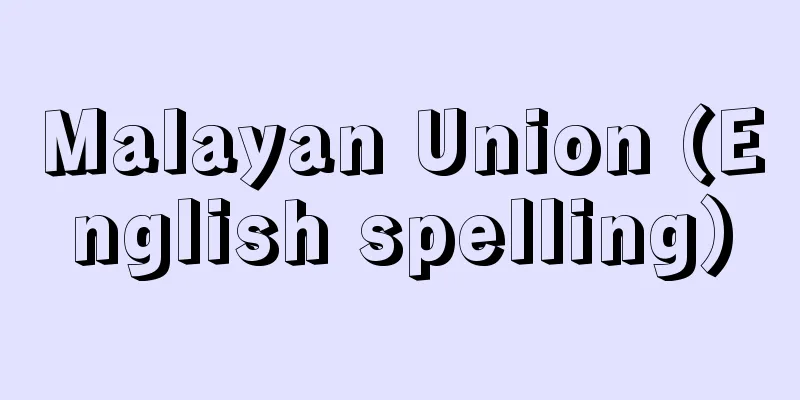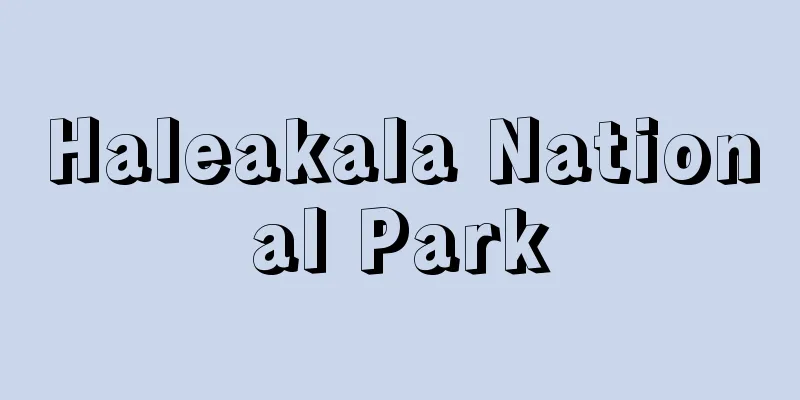Lebanon - Republic of Lebanon (English spelling)

|
A country in the western part of Western Asia, on the eastern coast of the Mediterranean Sea. Its official name is the Republic of Lebanon (Al-Jumhūrīya al-Lubnānīya). It borders Syria to the north and east, and Israel to the south. Its area is 10,400 square kilometers, roughly the same size as Gifu Prefecture, and its population is 3,755,000 (2004 estimate). Its capital is Beirut. The civil war that had been raging since 1975 ended in 1990 with Syrian intervention, and the country has begun its journey toward reconstruction. [Kazuo Takahashi] NatureExcept for the narrow plain along the Mediterranean coast, the country is generally mountainous, with the Lebanon Mountains running north to south in the center, with Mount Qurna al-Sauda (3,088m) as its highest peak, and the Anti-Lebanon Mountains, with Mount Hermon (2,815m) as its highest peak, running parallel to the Lebanon Mountains along the border with Syria. Between these mountain ranges stretches 120km north to south and 8 to 15km east to west, with the Orontes River flowing north and the Litani River flowing south. The Mediterranean coastal plains have a typical Mediterranean climate, with hot summers and little rain, but warm winters with rain, with annual precipitation reaching 1000 mm in some places. The average annual temperature in the capital Beirut is 19.7 °C, with a maximum of 26.5 °C in August and a minimum of 13.1 °C in January. The average annual precipitation is 825.5 mm, with most rain from November to February, and little rain and dry in the summer from June to September. The coastal slopes of the Lebanon Mountains, where there is a lot of precipitation, are covered with forests of pine and cedar trees. As you move inland, the amount of precipitation decreases, the climate becomes dry, and the summers are quite hot. However, in the high mountain areas, the temperature drops in winter, and snow is usually seen from December to May. There is a theory that this is the origin of the name Lebanon, because in Aramaic, white is "laban". Depending on the climate, skiing in the mountains and water skiing on the coast are possible at the same time, making it a rare country in the world. [Kazuo Takahashi] historyBlessed with good harbors, Lebanon has flourished as a trading center since ancient times. From around 3000 BC, the Phoenicians established many city-states, such as Tyre (now Tyre) and Sidon (now Saida), based on the coast. Later, it was ruled by Babylonia, Persia, Rome, and other countries, and during the Roman period, a naval base was established in Tyre and Christianity was spread there. However, after it was conquered by the Arabs who practiced Islam in the 7th century AD, Arabization and Islamization progressed. During this period, the mountainous region became a refuge for minority groups derived from Islam, such as Shiites and Druze, and Maronite Christians. In the 11th and 12th centuries, it became a battleground between the Seljuk Empire and the Crusaders, and in the 16th century it was annexed by the Ottoman Empire, and until the 19th century, semi-independent forces ruled Lebanon under the suzerainty of the Ottoman Empire. In the 19th century, the Ottoman Empire tried to rule Lebanon directly, but failed, and conflict broke out between the Maronites and the Druze, resulting in the deaths of many Christians. France intervened in this conflict, and under its pressure, the Maronites gained autonomy from the Ottoman Empire in 1861. After the Ottoman Empire was defeated in World War I, the inland areas such as the Bekaa Plateau were annexed to Lebanon at the San Remo Conference in April 1920. However, this measure resulted in Lebanon having a large Muslim population. This destroyed the overwhelming numerical superiority of the Maronites. In 1923, Lebanon became a French mandate territory along with Syria. However, in 1926, Lebanon separated from Syria and gained the status of an autonomous country under the mandate, and in January 1944, it achieved complete independence. After independence, Lebanon formed a unique sectarian federation against the backdrop of complex sectarian conflicts, promoted political neutrality and thorough economic liberalization, and maintained its own prosperity as a terminal for supplies and information for Arab countries. However, since the establishment of the state of Israel in 1948, it has inevitably been involved in the turmoil of the Middle East. Especially after the 1970 Jordanian civil war, a large number of Palestinians flowed into Lebanon, and Lebanon became a base for Palestinian guerrillas centered on the Palestine Liberation Organization (PLO), and was frequently subjected to Israeli retaliation attacks. In February 1975, a civil war broke out between Muslims who supported the Palestinian guerrillas and Christians who opposed them, leading to the intervention of the Syrian army in November 1976. Furthermore, in June 1982, Israel invaded Lebanon, completely surrounding West Beirut to wipe out the PLO, and bombing it fiercely for two months. In August of the same year, an agreement was reached with the PLO's withdrawal from West Beirut through US mediation, and about 10,000 PLO guerrillas left for eight Arab countries. After that, there were a series of incidents, including a massacre of Palestinian refugees by Christian militias in September 1982, an intensification of civil war between Christian and Islamic factions and US Navy naval bombardment in July-September 1983, and an explosion at the US and French garrison headquarters in October 1983. As a result, many casualties were suffered and the US and French forces withdrew. Furthermore, Shiites launched a guerrilla war against the Israeli army occupying the southern half of Lebanon. The Shiite guerrillas' death-defying attacks caused many casualties for the Israeli army, and Israel finally withdrew from Lebanon in 1985. However, Israel continued to occupy part of the southern part of the country as a "security zone," and a pro-Israeli Lebanese mercenary force called the "South Lebanon Army" was stationed there. There have been intermittent battles here between the Shiite organization Hezbollah and the Israeli army and the South Lebanese army. Due to the high number of casualties, calls for withdrawal grew in Israel, and in 2000 the Israeli army withdrew and the South Lebanese army was disbanded. However, tensions in the border area continue to persist. On July 12, 2006, Hezbollah kidnapped two Israeli soldiers in the Lebanon-Israel border area, and the Israeli army launched an invasion of southern Lebanon. Israeli airstrikes caused many civilian casualties, drawing criticism from the international community. Following a UN Security Council resolution, a ceasefire went into effect on August 14 of the same year, and on October 1, Israeli forces stationed in southern Lebanon withdrew and handed over the areas they controlled to the United Nations Interim Force in Lebanon (UNIFIL), but Israel was unable to wipe out Hezbollah's armed forces in the area. There are still 413,000 Palestinian refugees (2007) remaining in Lebanon. [Kazuo Takahashi] PoliticsThe National Pact, which was decided in 1943, stipulated that the president would be a Maronite Christian, the prime minister a Sunni Muslim, the speaker of parliament a Shiite Muslim, parliament members would be distributed in a ratio of 6 Christians to 5 Muslims, and cabinet members would also be distributed among each denomination. However, the basis of the National Pact was based on the 1932 census (54% Christian, 45% Muslim), and did not reflect the change in the population composition of the country, which had led to an increase in the number of Muslims, which caused strong dissatisfaction among Muslims. Conversely, the Christian side tried to maintain their privileges despite the change in the population balance. This was the background to the outbreak of the civil war in 1975. The civil war and the division of the various factions led to the intervention of neighboring countries such as Syria and Israel, as well as Iraq, France, and the United States. It was Iraq's invasion of Kuwait in 1990 that gave the civil war, which had undergone many changes, an opportunity to end. In order to isolate Iraq, the United States sought Syria's cooperation. Syria gained freedom of action in Lebanon in return for sending troops to the multinational forces and cooperating with the United States. Meanwhile, forces such as General Aoun, who opposed Syrian hegemony in Lebanon, relied on Iraqi aid. However, Iraq, isolated by the Gulf Crisis, stopped supporting Aoun. In an international environment favorable to them, the Syrian army took action, seizing the opportunity to isolate anti-Syrian forces. In October 1990, Aoun surrendered, ending the civil war. After that, all factions except Hezbollah were disarmed, and peace was established in Lebanon under Syrian power. The Syrian army continued to be stationed there, and in Lebanon, it was virtually impossible to do anything without ignoring Syria's wishes. In May 1991, the Syrian-Lebanese Brotherhood Cooperation and Coordination Treaty was signed, giving legal form to this current situation. In April 2005, the Syrian army, which had been stationed in Lebanon for 29 years, withdrew due to the demands of the Lebanese people and the international situation, but the conflict between pro- and anti-Syrian factions continued, with clashes between the armed group Fatah Islam and the Syrian army in 2007 and Hezbollah taking control of West Beirut by force in 2008, but these were calmed down by the Doha Agreement. A national unity government was formed in July. In domestic affairs, changes were made to the system based on the Charter of National Reconciliation agreed upon in Taif, Saudi Arabia in 1989. This strengthened the voice of Muslims. For example, under the old system, Christians had an advantage in the number of members of parliament, but under the new system, Christians and Muslims have an equal number of members. Similarly, the number of cabinet members is also equal. The parliament is unicameral with 128 seats, and the term of office is four years. The political system is a republic. The head of state is the president, whose term of office is six years. [Kazuo Takahashi] Economy and IndustryBefore the civil war, the country relied on the tertiary industry for about 70% of its gross domestic product, with a large amount of non-trade income from transit trade centered on the free port of Beirut, financial services, tourism revenues, and remittances from overseas migrants. The financial industry in particular saw remarkable development, and the country adopted a free economic policy that included the abolition of exchange restrictions in 1952 and the liberalization of financial activities. As a pillar of transit trade, the country also became an oil export base for Arab oil-producing countries, and constructed pipelines from Iraq's Kirkuk oil fields and Saudi Arabia's oil fields to the Mediterranean coast, including Tripoli, earning large amounts of transit fees. Tourism is also an important industry. In addition to being blessed with natural conditions that make it a great summer and winter resort, the country also has many ruins dating back to the Phoenician era, such as the Temple of Baalbek, and the high level of medical care has led to many wealthy people from all over the Middle East staying there for long periods of time for medical treatment and recuperation. However, the economy was devastated by the civil war and political instability after 1975. When the civil war ended in 1990, the government made economic recovery its priority goal. This policy was embodied by Rafiq al-Hariri (1944-2005), who became prime minister in October 1992. Hariri made a fortune through construction work in Saudi Arabia. Under the Hariri cabinet, the Lebanese economy grew at an annual rate of 7% until 1995. In order to restore the prosperity it had before the civil war, efforts were being made to restore infrastructure such as finance, tourism, medical care, and education. The demand for funds for reconstruction was enormous, and domestic deposits alone could only cover about one-third of the demand. The introduction of funds from overseas was the key to the speed of reconstruction. Some also hoped that Hariri's close relationship with Saudi Arabia would lead to a flow of funds from oil-producing countries in the Persian Gulf. Investment in Lebanon by Lebanese abroad, estimated at at least $40 billion, is also important, reminiscent of the investments made by overseas Chinese that helped China take off economically. In 1996, the growth rate fell to around 4% per year, a trend that has continued since 1997. One of the reasons for the decline in the economic growth rate was Operation Grapes of Wrath, a large-scale attack by Israel on southern Lebanon in 1996. Casting a dark shadow over the economy of the entire region, including Lebanon, is the fact that the Middle East Peace Process has essentially stalled. Lebanon's exports are mainly textiles, jewels, chemical products, fruits, and vegetables, while its imports are mainly vehicles, electrical appliances, petroleum products, and pharmaceuticals. The total export amount was $3.478 billion, while the import amount was $16.137 billion (2008). The main export destinations are Syria, the United Arab Emirates, Switzerland, and Saudi Arabia, while the main import destinations are Syria, Italy, France, the United States, and China. The trade balance is a large excess of imports, which is made up for by the introduction of foreign capital. The country's finances are also in a chronic deficit, which is also being balanced by the inflow of foreign capital. For these reasons, the country's external debt reached approximately $47 billion at the end of 2008. This is twice the country's gross domestic product of $24 billion (2007), and a large portion of tax revenue is being used to pay the interest on the debt. In order for Lebanon to make progress in its reconstruction, it is time for economic reform. The main donor countries in 2006 were the United States with approximately $91 million, France with $74 million, Italy with $44 million, Germany with $29 million, and Norway with $28 million. In terms of economic relations with Japan, Lebanon has a large import surplus with exports of $4.5 million and imports of $619.8 million (2008). The main exports to Japan are non-ferrous metals such as aluminum and copper scrap, and chemical products, while the main imports from Japan are automobiles, electrical products, and electrical equipment. As of the end of 2007, Japan's aid amounted to approximately 13 billion yen in loan aid, approximately 2.8 billion yen in grant aid, and approximately 1.15 billion yen in technical cooperation. [Kazuo Takahashi] Society and CultureThe official language is Arabic, but French and, more recently, English are widely spoken, and most educated people speak all three languages. For political reasons, no official census has been conducted since 1932, but estimates from the 1980s put Muslims at 60% of the population. Several factors have been cited for the increase in the Muslim population. These include a higher birth rate among Muslims, who are relatively poorer than Christians, the fact that many of the Palestinian refugees who came to the country were Muslim, and the fact that well-educated Christians have more opportunities to emigrate or work abroad. As a result of these factors, Shiite Muslims, who live mainly in the south, have grown to become the largest group in terms of population. Reflecting the historical background of persecuted minorities fleeing to the mountains of Lebanon, the city is home to a wide variety of denominations, so much so that it is called a "living museum of religions." The main denominations include Shiite, Sunni, and Druze Islam, as well as Maronite, Greek Orthodox, Greek Catholic, Armenian Orthodox, Catholic, and Protestant Christians. During the civil war, many Lebanese left the country, causing a sharp decline in its population, but after the war ended people began to return, resulting in a high population growth rate. It also has one of the highest population densities in the world. Since the end of the 19th century, Lebanon has sent as many as 2.5 million people to North America, Africa, and other places. Many of them have become famous, such as Ralph Nader, the leader of the American consumer movement, who is of Lebanese descent. Lebanese immigrants tend to maintain close ties with their hometowns even after successive generations, and remittances from immigrants and migrant workers are a valuable source of income for Lebanon, accounting for one-third of its gross national product. The education system is a 6-3-3 system with six years of elementary school, three years of junior high school, and three years of high school, but there are also schools with a 5-4-3 system based on the French system with five years of elementary school, four years of junior high school, and three years of high school. Compulsory education is six years, and classes are conducted in the official language Arabic, as well as in English or French, and the level of education is high. The American University of Beirut, founded in the 19th century, attracted talented students from all over the Middle East before the civil war. There are also 12 other universities, including the Lebanese University, a national comprehensive university, and the Catholic University of Saint Joseph. Some of these were founded during the civil war, which shows the high expectations that Lebanon has for education. Many newspapers have been published in Lebanon since ancient times. Arabic dailies include An-Nahar, Al-Anwar, and Al-Safil, each with its own unique stance, such as neutral, conservative, or left-wing. English dailies include The Daily Star, Lebanon News Wire, and Al-Hayat. In addition to state television, other television stations include LBC (Lebanese Broadcasting), Fuqi Television, and the Hezbollah-affiliated Al-Manar. [Kazuo Takahashi] "The History of Lebanon, by P.K. Hitti, translated by Shinjiro Kodama (1977, Yamamoto Shoten)" ▽ "The New Middle East Handbook, edited by Yuzo Itagaki (1992, Kodansha)" ▽ "The Political Structure of Modern Syria and Lebanon, by Hiroyuki Aoyama and Kota Suechika (2009, Iwanami Shoten)" [References] | | | | | | | | | | | | | | | [Additional Resources] |"> Lebanon flag ©Shogakukan Illustration/Shogakukan Creative "> Lebanon Location Map Located in northeastern Lebanon, it is the largest holy site in the Roman Empire. Although it has been damaged by earthquakes and civil wars, it still boasts a magnificent appearance as a relic of the holy site. World Cultural Heritage "Baalbek" (Lebanon, registered in 1984) Lebanon Baalbek ©Shogakukan "> Ruins of Baalbek Source: Shogakukan Encyclopedia Nipponica About Encyclopedia Nipponica Information | Legend |
|
西アジア西部、地中海東岸にある国。正称レバノン共和国Al-Jumhūrīya al-Lubnānīya。北および東はシリア、南はイスラエルと国境を接する。面積は1万0400平方キロメートルで岐阜県と同じくらい、人口375万5000(2004推計)。首都はベイルート。1975年以来の内戦がシリアの介入によって1990年に終結し、復興への歩みを始めた。 [高橋和夫] 自然地中海沿岸の狭い平野部を除いて全体に山がちで、中央部にはクルナ・アル・サウダ山(3088メートル)を最高峰とするレバノン山脈が南北に走り、シリアとの国境沿いにはヘルモン山(2815メートル)を最高峰とするアンティ・レバノン山脈が、レバノン山脈と並行して連なる。これらの山脈の間には南北120キロメートル、東西8~15キロメートルにわたって、標高1000メートル内外のベカー高原が広がり、オロンテス川が北流し、リタニ川が南流する。 地中海沿岸平野は典型的な地中海性気候を示し、夏は高温で寡雨となるが冬は温暖で降水があり、年降水量は所によっては1000ミリメートルに達する。首都ベイルートの年平均気温は19.7℃、最高は8月の26.5℃、最低は1月の13.1℃。年降水量は825.5ミリメートルで11月から2月に雨が多く、6月から9月までの夏は雨が少なく乾燥している。多量の降水があるレバノン山脈の海岸側斜面は、松柏(しょうはく)類やレバノンスギなどの森林に覆われている。内陸に移るにつれて降水量は減少し、気候は乾燥して夏はかなりの高温となる。しかし高山地帯では冬には気温が下がり、通常12月から5月にかけては雪が見られる。これがレバノンという地名の語源になったとの説もある。なぜならばアラム語で白は「ラバーン」だからである。気候によっては山地ではスキーが、海岸部では水上スキーが同時に可能な、世界でもまれな国である。 [高橋和夫] 歴史良港に恵まれたレバノンは古くから交易の中心として栄えてきた。紀元前3000年ごろからフェニキア人が海岸地帯を根拠地とし、ティルス(現、ティール)、シドン(現、サイダ)など多くの都市国家を建設した。その後、バビロニア、ペルシア、ローマなどの支配が及び、ローマ時代にはティルスに海軍基地が置かれ、キリスト教が広められた。しかし、紀元後7世紀にイスラム教を奉じるアラブ人に征服されて以後、アラブ化、イスラム化が進行した。この時代には山岳地帯がシーア派、ドルーズ派などイスラム教から派生した少数派やマロン派キリスト教徒などの避難地となった。11~12世紀にはセルジューク朝と十字軍との争奪の場となり、16世紀にはオスマン帝国に併合され、19世紀まで同帝国の宗主権の下で、半独立的な諸勢力がレバノンを支配した。19世紀に入るとオスマン帝国はレバノンの直接支配を試みたが失敗し、マロン派キリスト教徒とドルーズ派の間で紛争が起こり、多数のキリスト教徒が殺害された。この紛争にフランスが介入し、その圧力の下に1861年、マロン派キリスト教徒はオスマン帝国から自治権を獲得した。さらに第一次世界大戦でオスマン帝国が敗れると、1920年4月のサン・レモ会議で、ベカー高原などの内陸部もレバノンに併合された。しかし、この措置によってレバノンは多数のイスラム教徒を抱えることとなった。これにより、マロン派キリスト教徒の数のうえでの圧倒的な優位が崩れた。そして1923年にはシリアとともにフランスの委任統治領となった。だが、1926年、シリアから分離して委任統治下での自治国の地位を獲得し、1944年1月に完全独立を達成した。 独立後のレバノンは、複雑な宗派の対立を背景に独特の宗派連合国家を形成し、政治的には中立主義、経済的には徹底した自由化政策を推進し、アラブ諸国の物資と情報のターミナルとして独自の繁栄を保ってきた。しかし、1948年のイスラエルの建国以来、中東情勢の激動に必然的に巻き込まれることになった。とくに1970年のヨルダン内戦以後、同国より多数のパレスチナ人が流入し、レバノンはパレスチナ解放機構(PLO)を中心としたパレスチナ・ゲリラの根拠地となり、たびたびイスラエルの報復攻撃を受けた。1975年2月にはパレスチナ・ゲリラを支援するイスラム教徒とそれに反対するキリスト教徒の内戦が起こり、1976年11月にシリア軍の介入を招いた。さらに1982年6月、イスラエルがレバノンへ侵攻し、PLOの掃討のため西ベイルートを完全包囲し、2か月にわたって猛爆撃した。同年8月アメリカの調停によりPLOの西ベイルート撤退で合意が成立し、約1万人のPLOゲリラはアラブ8か国へ退去した。それ以後も、1982年9月のキリスト教民兵によるパレスチナ難民虐殺事件、1983年7~9月のキリスト教、イスラム教各派による内戦の激化とアメリカ海軍の艦砲射撃、1983年10月のアメリカおよびフランスの駐屯本部での爆発事件などが相次いだ。その結果、多くの犠牲を出し、アメリカ軍やフランス軍は撤退した。さらにレバノンの南半分を占領するイスラエル軍に対してシーア派がゲリラ戦を挑んだ。シーア派ゲリラの死をいとわぬ攻撃によってイスラエル軍は多くの犠牲者を出し、イスラエルはついに1985年にレバノンから撤退した。しかし、その後も南部の一部は「安全保障地帯」としてイスラエルによる占領が続き、「南レバノン軍」という親イスラエルのレバノン人傭兵(ようへい)部隊が配置されていた。ここではシーア派の組織ヒズボッラー(ヒズボラ)と、イスラエル軍および南レバノン軍とのあいだで交戦が断続的に行われていた。犠牲の多さからイスラエルでは撤退を求める声が高まり、2000年にイスラエル軍は撤退、南レバノン軍は解体した。ただし国境地帯の緊張は依然続いている。 2006年7月12日レバノンとイスラエルの国境地帯で、ヒズボッラーがイスラエル兵2名を拉致(らち)したことに対しイスラエル軍がレバノン南部に侵攻を開始。イスラエル軍の空爆により民間人の死傷者が多数出るなどして、同軍は国際社会の非難を浴びた。その後、国連安保理決議を受け、同年8月14日に停戦が発効、10月1日にはレバノン南部に駐留していたイスラエル軍が撤退し国連レバノン暫定軍(UNIFIL)に支配地域を引き渡したが、イスラエルはこの地域でのヒズボッラーの武装勢力を一掃することはできなかった。 なお41万3000人(2007)のパレスチナ難民がレバノンに残されたままとなっている。 [高橋和夫] 政治1943年に決定された国民協約では、大統領はマロン派キリスト教徒、首相はスンニー派イスラム教徒、国会議長はシーア派イスラム教徒、国会議員はキリスト教徒6、イスラム教徒5の比率で配分し、閣僚も各宗派に配分することなどが規定されていた。しかし、国民協約の基礎は1932年の人口調査(キリスト教徒54%、イスラム教徒45%)に基づいたもので、イスラム教徒が増加したという人口構成の変化を反映しておらず、イスラム教徒の不満が強かった。逆にキリスト教徒側は人口のバランスの変化にもかかわらず特権を保持し続けようとした。これが1975年の内戦勃発(ぼっぱつ)の背景となった。内戦と各派の分裂はシリア、イスラエルなどの周辺諸国ばかりでなくイラク、フランス、アメリカなどの介入を招いた。幾多の変転を経た内戦に終結の機会を与えたのは、1990年のイラクのクウェート侵攻であった。イラクを孤立させるためにアメリカはシリアの協力を仰いだ。シリアは多国籍軍に派兵してアメリカに協力した見返りに、レバノンでの行動の自由を得た。一方レバノンでのシリアの覇権に反対していたアウン将軍などの勢力はイラクの援助に依存していた。しかし湾岸危機で孤立したイラクからアウンへの支援がとぎれた。自らに有利な国際環境下、反シリア勢力の孤立という機会を逃さずにシリア軍が動いた。1990年10月アウンが降伏して内戦が終結した。その後ヒズボッラーを除く各派の武装解除が行われ、レバノンにシリアの力による平和が確立された。シリア軍はその後も駐留を続け、レバノンでは実質上シリアの意向を無視しては何事も行えない状況が続いていた。1991年5月にはシリア・レバノン同胞協力調整条約が調印され、シリアはこの現状に法的な体裁を整えた。その後、レバノン国民の要求や国際情勢などから、2005年4月に29年間レバノンに駐留してきたシリア軍は撤退したが、反シリア派と親シリア派の対立は続き、2007年には武装勢力ファタハ・イスラームと国軍の衝突、2008年にはヒズボッラーによる西ベイルート武力制圧が行われたが、ドーハ合意によって沈静化。7月に挙国一致内閣が成立した。 内政面では1989年サウジアラビアのタイーフで合意された国民和解憲章に基づいて体制の変更が実施された。これはイスラム教徒の発言権を強めるものである。たとえば議員数では旧制度の下ではキリスト教徒優位であったが、新しい制度ではキリスト教徒とイスラム教徒が同数となった。同様に閣僚数も同数となった。議会は一院制で128議席、任期は4年。政体は共和制。元首は大統領、任期は6年。 [高橋和夫] 経済・産業内戦以前は自由港ベイルートを中心とする中継貿易と金融業、観光収入、海外移住者の送金などの貿易外収入が多く、国内総生産の約70%を第三次産業に依存していた。とくに金融業の発展は著しく、1952年に為替(かわせ)制限を撤廃し、金融活動を自由化するなどの自由経済政策をとっていた。また中継貿易の柱として、アラブ産油国の石油輸出基地となり、イラクのキルクーク油田やサウジアラビアの油田からトリポリなど地中海岸へのパイプラインを建設し、多額の通過料を得ていた。観光も重要な産業である。避暑地、避寒地としての自然条件に恵まれているほか、バールベック神殿などフェニキア時代以来の遺跡も多く、また医療水準が高いため、中東各地の富裕層が病気治療と保養のために長期滞在する例も多かった。 しかし、1975年以後の内戦と政情不安によって経済は壊滅的打撃を受けた。1990年に内戦が終結すると政府は経済復興を優先目標として掲げた。その政策を体現したのが1992年10月に首相に就任したラフィーク・ハリーリRafiq al-Hariri(1944―2005)である。ハリーリは、サウジアラビアでの建設工事で巨富を築いた人物である。ハリーリ内閣の下でレバノン経済は1995年まで年率7%の成長を実現した。内戦前の繁栄を取り戻すために、金融、観光、医療、教育などのインフラ(基盤)の復興に力が入れられている。復興への資金需要は膨大であり、国内預金だけでまかなえるのは、せいぜい3分の1程度にすぎない。海外からの資金の導入が、復興のスピードを決める鍵(かぎ)である。また一部ではハリーリのサウジアラビアとの密接な関係が、ペルシア湾岸の産油諸国からの資金の流れを導くのではと期待されていた。海外に居住するレバノン出身者が保有する、最低でも400億ドルともいわれる資金のレバノンへの投資も重要である。華僑(かきょう)の投資が中国の経済的な離陸を助けた例が想起される。 1996年には成長率は年で4%程度にまで低下し、1997年以降もその傾向は続いている。経済成長率の低下の一因は、1996年に行われたイスラエルによる南部レバノンへの大規模な攻撃「怒りの葡萄(ぶどう)作戦」であった。レバノンを含む地域全体の景気に暗い影を投げかけているのは、中東和平プロセスが実質上止まっていることである。 レバノンの輸出品は、繊維、宝石、化学製品、果物、野菜などが中心で、輸入品は車両や電気製品、石油製品、医薬品が多い。輸出額は34億7800万ドル、輸入額は161億3700万ドル(2008)、おもな輸出相手国はシリア、アラブ首長国連邦、スイス、サウジアラビアなど、おもな輸入相手国はシリア、イタリア、フランス、アメリカ、中国など。貿易収支は大幅な輸入超過で、外資の導入によって埋め合わせられている。また財政も赤字状態が慢性化しており、これもまた外資の流入によってなんとか帳尻(ちょうじり)があわされている。こうした理由から2008年末には対外累積債務が約470億ドルにも達している。国内総生産240億ドル(2007)の2倍にも上る額であり、税収のかなりの部分がその利子の支払いに使われている。レバノンの復興進展のためには、経済の改革が必要な時期に入っている。2006年のおもな援助国はアメリカ約9100万ドル、フランス7400万ドル、イタリア4400万ドル、ドイツ2900万ドル、ノルウェー2800万ドルなどとなっている。日本との経済関係では、輸出額450万ドル、輸入額6億1980万ドルとレバノンの大幅輸入超過になっている(2008)。日本へのおもな輸出品目はアルミニウムや銅くずなどの非鉄金属、化学製品など、日本からのおもな輸入品目は自動車、電気製品、電気機器などである。2007年末までの日本の援助は有償資金協力約130億円、無償資金協力約28億円、技術協力約11億5000万円となっている。 [高橋和夫] 社会・文化公用語はアラビア語であるが、フランス語が、そして最近では英語が普及しており、教育を受けた人々の多くはこの3か国語を話す。 政治的な理由から1932年以来公式の人口調査は行われていない。しかし1980年代の推定ではイスラム教徒が人口の6割を占めている。イスラム教徒の増加にはいくつかの要因が指摘されている。貧しい層が比較的多いイスラム教徒のほうがキリスト教徒より出生率が高いこと、難民として流入したパレスチナ人の多くがイスラム教徒であったこと、さらには教育水準の高いキリスト教徒のほうが海外への移住や出稼ぎに出る機会が多いことなどである。こうした要因の結果として南部を中心に生活するイスラム教徒シーア派が、人口では最大のグループに成長している。 迫害を受けた少数派がレバノンの山地に逃れたという歴史的な経緯を反映して、宗派は多種多様であり、「生きた宗教の博物館」とよばれるほどである。おもなものにはイスラム教のシーア派、スンニー派、ドルーズ派、そしてキリスト教のマロン派、ギリシア正教、ギリシア・カトリック、アルメニア正教、カトリック、プロテスタントなどが存在する。 内戦中は多くのレバノン人が国を離れたため人口は激減したが、戦争が終わると人々が戻り始めた。その結果として高い人口増加率をみせている。また人口密度の高さも世界で有数である。 19世紀末よりレバノンは250万にも上る人々を北アメリカやアフリカなどに送り出してきた。そのなかには著名となった人物も多い。たとえばアメリカの消費者運動のリーダー、ラルフ・ネーダーRalph Naderはレバノン系の人物である。レバノン移民は、世代を経ても故郷と密接な関係を維持する傾向が強く、移民や出稼ぎからの送金はレバノンにとっては貴重な収入源であり、国民総生産の3分の1にもあたるとされている。 教育制度は小学校6年、中学校3年、高等学校3年の六・三・三制だが、フランス方式の小学校5年、中学校4年、高等学校3年の五・四・三制の学校もある。義務教育は6年間で、授業は公用語のアラビア語のほかに英語あるいはフランス語で行われており、教育水準は高い。19世紀に設立されたアメリカン・ベイルート大学は、内戦前は中東全域から俊英を集めていた。ほかに国立総合大学のレバノン大学、カトリック系のセント・ジョセフ大学など12の大学が存在している。そのなかには内戦の間に設立されたものもあり、レバノンが教育にかける期待の大きさをうかがわせる。レバノンでは昔から多くの新聞が発刊されてきた。アラビア語日刊紙にはアンナハル、アルアンワル、アッサフィルなどがあり、それぞれ中立系、保守系、左派系などの独自の主張をもっている。英語日刊紙にはザ・ディリー・スター、レバノン・ニュース・ワイヤー、アルハヤトなどがある。テレビ局は国営テレビのほかにLBC(レバノン放送)、フューチー・テレビジョン、ヒズボッラー系のアルマナルなどがある。 [高橋和夫] 『P・K・ヒッティ著、小玉新次郎訳『レバノンの歴史』(1977・山本書店)』▽『板垣雄三編『新中東ハンドブック』(1992・講談社)』▽『青山弘之・末近浩太著『現代シリア・レバノンの政治構造』(2009・岩波書店)』 [参照項目] | | | | | | | | | | | | | | | [補完資料] |"> レバノンの国旗 ©Shogakukan 作図/小学館クリエイティブ"> レバノン位置図 レバノン北東部に位置する、ローマ帝国最大の聖地。地震や内戦によって被害を受けたが、聖地の遺構として偉容を誇っている。世界文化遺産「バールベック」(レバノン・1984年登録) レバノン バールベック©Shogakukan"> バールベックの遺跡 出典 小学館 日本大百科全書(ニッポニカ)日本大百科全書(ニッポニカ)について 情報 | 凡例 |
>>: Lebanon [Mountains] - Lebanon
Recommend
Exsolution
① exsolution : (1) When the properties of the atom...
Belize - Belize (English spelling)
Located in the northeast of the Central American ...
Belcari, F.
…In the 15th century, writers who wrote religious...
Mathematical table
A table of values of function f ( x ) correspond...
Hanawa basin - Hanawabonchi
A graben basin in the upper reaches of the Yonesh...
Aristarchus (of Samos)
Greek astronomer from 310-230 BC. From the island ...
Isooctane
An aliphatic saturated hydrocarbon (alkane). It i...
Matsuo [village] - Matsuo
A village in Iwate County, northwest of Iwate Pref...
"Ehen Taikouki" - Ehen Taikouki
...The term "acharaka play," which refe...
Hudson's Bay Company
The British Chartered Company, which had a monopol...
Tiger Fern
An evergreen fern of the family Pteridophyllaceae....
Visayas [Islands] - Visayas
A general term for the islands scattered between t...
Mount Yoshino
<br /> A mountain range in Yoshinoyama, Yosh...
Iwakiyama Shrine
It is located in Terasawa, Hyakuzawa, Hirosaki Ci...
Thieves' Church Council - Thieves' Church Council
An ecumenical council held in Ephesus, Asia Minor,...









